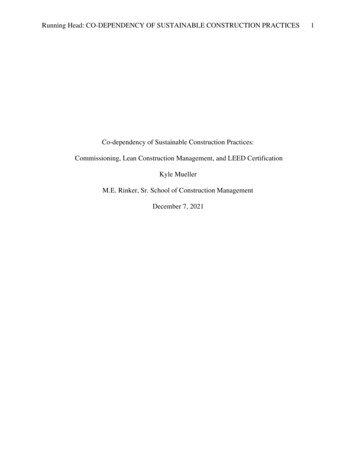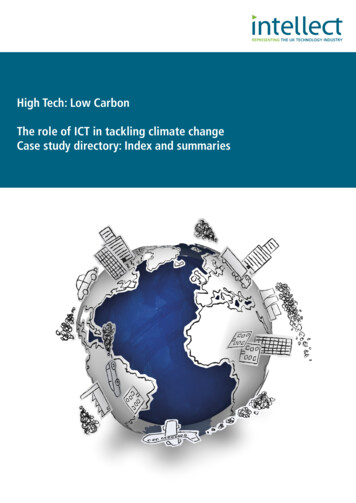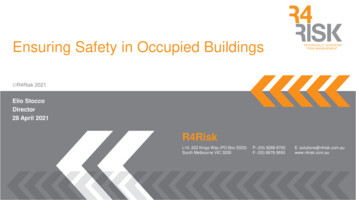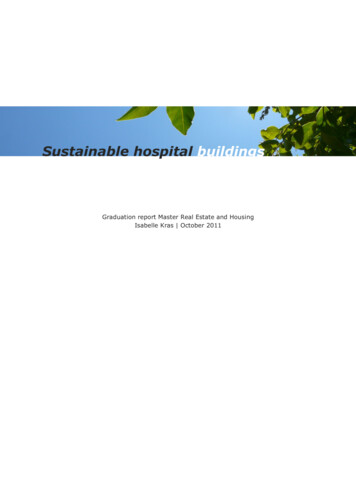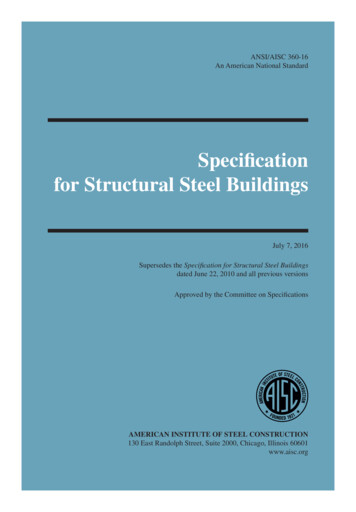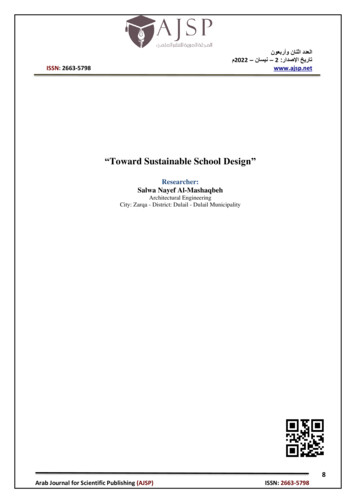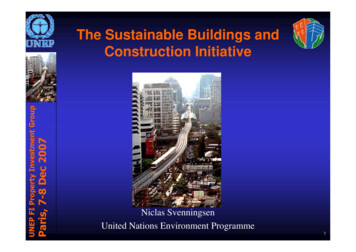
Transcription
Paris, 7-8 Dec 2007UNEP FI Property Investment GroupThe Sustainable Buildings andConstruction InitiativeNiclas SvenningsenUnited Nations Environment Programme1
Why Building & Construction? 5-15 % of direct employment (111million jobs) Investment US 3000 billion/year(10 % of GDP) To growth markets: Brazil, China andIndia ( 10%)Paris, 7-8 Dec 2007UNEP FI Property Investment GroupThe building and construction market The built environment2
SBCI in a nutshell:Seeks to address commonglobal challenges tosustainability in the B&CsectorParis, 7-8 Dec 2007UNEP FI Property Investment GroupPartnership between thePrivate Sector and theUnited Nations (UNEP).Builds on synergies withother initiatives.Key objectives: Life Cycle Approach towards a sustainable Building and ConstructionsectorGlobal and sector cross-cutting initiativeFocus on common and worldwide challengesMove beyond recommendations towards implementation3
The SBCI MembersParis, 7-8 Dec 2007UNEP FI Property Investment GroupMembers drawn from throughout the lifecycle of buildingsMembers support SBCI throughmembership fees and directinvolvement in implementationAs of 15 October 2006SBCI has 27 membersfrom 14 countries,including China4
1. Climate Change: Qualify buildings andconstruction activities as eligibleactivities for support under the flexiblemechanisms of the Kyoto protocol.Paris, 7-8 Dec 2007UNEP FI Property Investment GroupTwo Key Focus Ares2. Economic incentives: Develop andpromote economic incentives for a lifecycle approach (LCA) in design,construction and financing of buildings,so as to create market conditionsfavourable to buildings that areoptimized from a life cycle perspective.5
1. Background study onBuildings and EnergyEfficiency2. Think Tank Elaborating recommendationsfor SBCIParis, 7-8 Dec 2007UNEP FI Property Investment GroupFocus Area 1: Climate Change3. Working group Responding to TTrecommendations4. CDM projects in North Africa Learning by doing5. Partnerships with MTF,WBCSD etc.6
Focus Area 2: Economicinstruments for LCA To develop know-howParis, 7-8 Dec 2007UNEP FI Property Investment Group1. Support global network ofexperts2. Project on Public FinanceMechanisms for energyefficiency in buildings3. Think Tank on economicincentives4. Partners (UNEP FI, LCI)7
Other activities Outreach & CommunicationParis, 7-8 Dec 2007UNEP FI Property Investment Group Tsunami reconstruction project Changsha Greenbuild Davos8
UNEP FI Property Investment GroupParis, 7-8 Dec 2007SBCI Communication9
Buildings and Climate Change- SBCI First Strategic Report -Paris, 7-8 Dec 2007UNEP FI Property Investment GroupTo find the answer to a few basicquestions: What do we know about energy usein buildings? What factors decide how muchenergy we use? What barriers are there to reducedenergy use? What instruments exist forencouraging energy efficientbuilding? Recommendations10
Paris, 7-8 Dec 2007UNEP FI Property Investment GroupThe Baseline 30-40% of global energy consumption takes place inthe B&C sector (IEA) Lack of reliable data, especially for developingcountries Biomass use in developing countries significant Potential energy savings are often 50% Energy use in construction phase is typically about5-15% of total energy use over the life cycle11
ubSahaAsraniaAf(ericxcal.MiddleEast)Paris, 7-8 Dec 2007UNEP FI Property Investment GroupThe Baseline10090Commercial & Public ServicesResidential706050403020100Energy use in residential vs commercial sectors12
Sources for energy consumptionResidential, KuwaitCommercial, IndiaCommercial, USAParis, 7-8 Dec 2007UNEP FI Property Investment GroupResidential, IndiaheatingResidential, USAcoolingRural residential, Chinalightingwater heatingUrban residential, ChinaothersCommercial, AustraliaResidential, AustraliaCommercial, CanadaResidential, Canada0%20 %40 %60 %80 %100 %13
Energy efficiency factorsIt is technically possible to build significantly lessenergy consuming housesNaturalVentilation;WindowsResidential building, 10 storeys,10 000m2.Shading;41,2 %Reference case (RC) vs low energycase (LE)16,1 %2506464InsulatedEnvelope;9KWh/m2200Paris, 7-8 Dec 2007UNEP FI Property Investment Group30028Advanced924,5 %OtherGlazing; ,60New York,New York,USA -RCUSA -LENewDelhi,India - na -China -Spain -Spain -India - LERCLERCLE14
Energy efficiency factors Construction phase: Embodied energy Use phase: Envelope Need for, and use of, insulation.Paris, 7-8 Dec 2007UNEP FI Property Investment Group E.g. Steel vs. glulam or new vs. recycled aluminium Use phase: Energy dependent systems; HVAC, hot water, lighting, appliances and other electricequipment Use phase: Human behaviour Demolition phase: Recycling15
Energy efficiency factorsParis, 7-8 Dec 2007UNEP FI Property Investment Group Opportunities on heating/cooling Low temperature heating systems Good design High efficiency A/C Window design and technology Cooking Low-energy house 60% reduction Conservation before energysystem: Integration! Passive house16
Paris, 7-8 Dec 2007UNEP FI Property Investment GroupNew or refurbishedbuildings? Europe: 1-2 % renewal ofbuilding stock, 70% built beforefirst energy crisis and ½ before1950. Developing world: Shorter lifespan and more urgent need fornew buildings. Focus on added insulation Solar heating when suitable Flexible solutions of energysystems Consider commissioning17
Encouraging energy efficiency Economic potentials significant Policies & Legislation Economic instruments:Paris, 7-8 Dec 2007UNEP FI Property Investment Group(But lack of wall breaking figure) Dynamic tariffs (Real pricing?) Energy audit (subsidized) Information & Education EU - You control climate change Parow pilot energ efficient retrofit and employee awarenesscampaign Technology transfer18
Encouraging energy efficiencyParis, 7-8 Dec 2007UNEP FI Property Investment GroupPolicies and legislation India: Energy Conservation Act EU Directive on the energy performance of buildings Scandinavia: Standards & building codes Russia: law on energy savings China: Policy on 65% energy efficiency improvement19
Paris, 7-8 Dec 2007UNEP FI Property Investment GroupBarriers (Perception of) costs for energy efficient solutions Disconnect between builders and users Inadequate knowledge about benefits of, andopportunities for, energy efficiency Lack of technical know-how and basic equipment Lack of funding No immediate priority in many cases Incentives not tailored to the building sector Owners that do not pay the energy bill Kyoto flexible mechanisms not tailoredto large number of small activities20
Paris, 7-8 Dec 2007UNEP FI Property Investment GroupSummary1. SBCI has JUST started2. Rapidly growing interest andattention, even from highestlevels3. Key issue is climate change,linked to economy of energysavings4. Technology is there but notthe means to mainstream it5. SBCI has a narrow focus buta multi-pronged approach21
For more informationwww.unep.frParis, 7-8 Dec 2007UNEP FI Property Investment GroupThank You!Niclas SvenningsenUNEPTel: 33-1- 44 37 14 33Fax: 33 - 1 - 44 37 14 74E-mail: nsvenningsen@unep.fr22
SBCI has a narrow focus but a multi-pronged approach. UNEP FI Property Investment Group Paris, 7-8 Dec 2007 22 Niclas Svenningsen UNEP Tel: 33-1- 44 37 14 33 Fax: 33 - 1 - 44 37 14 74 E-mail: nsvenningsen@unep.fr For more information www.unep.fr Thank You! Title: Microsoft PowerPoint - 3unep_sbci.ppt




